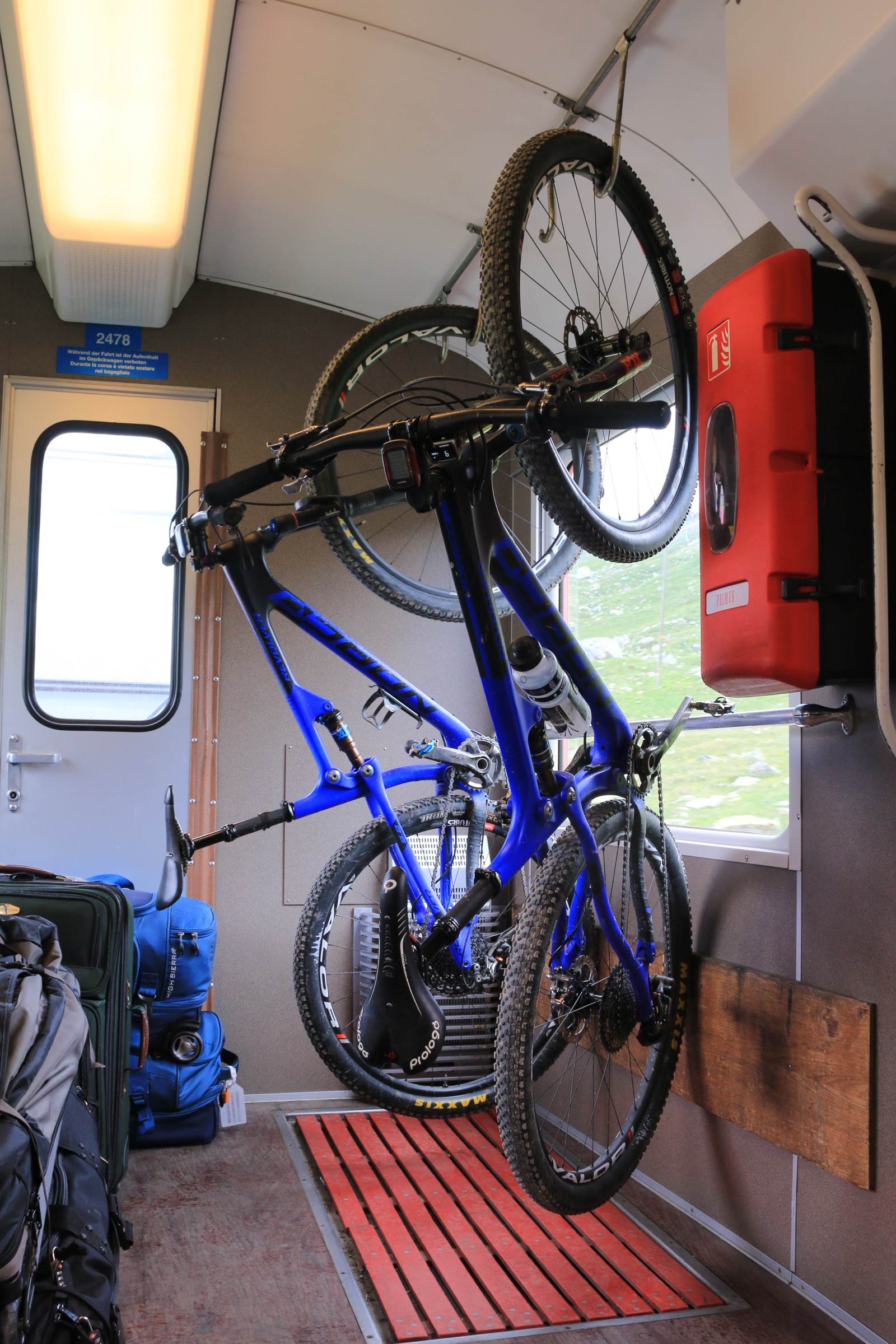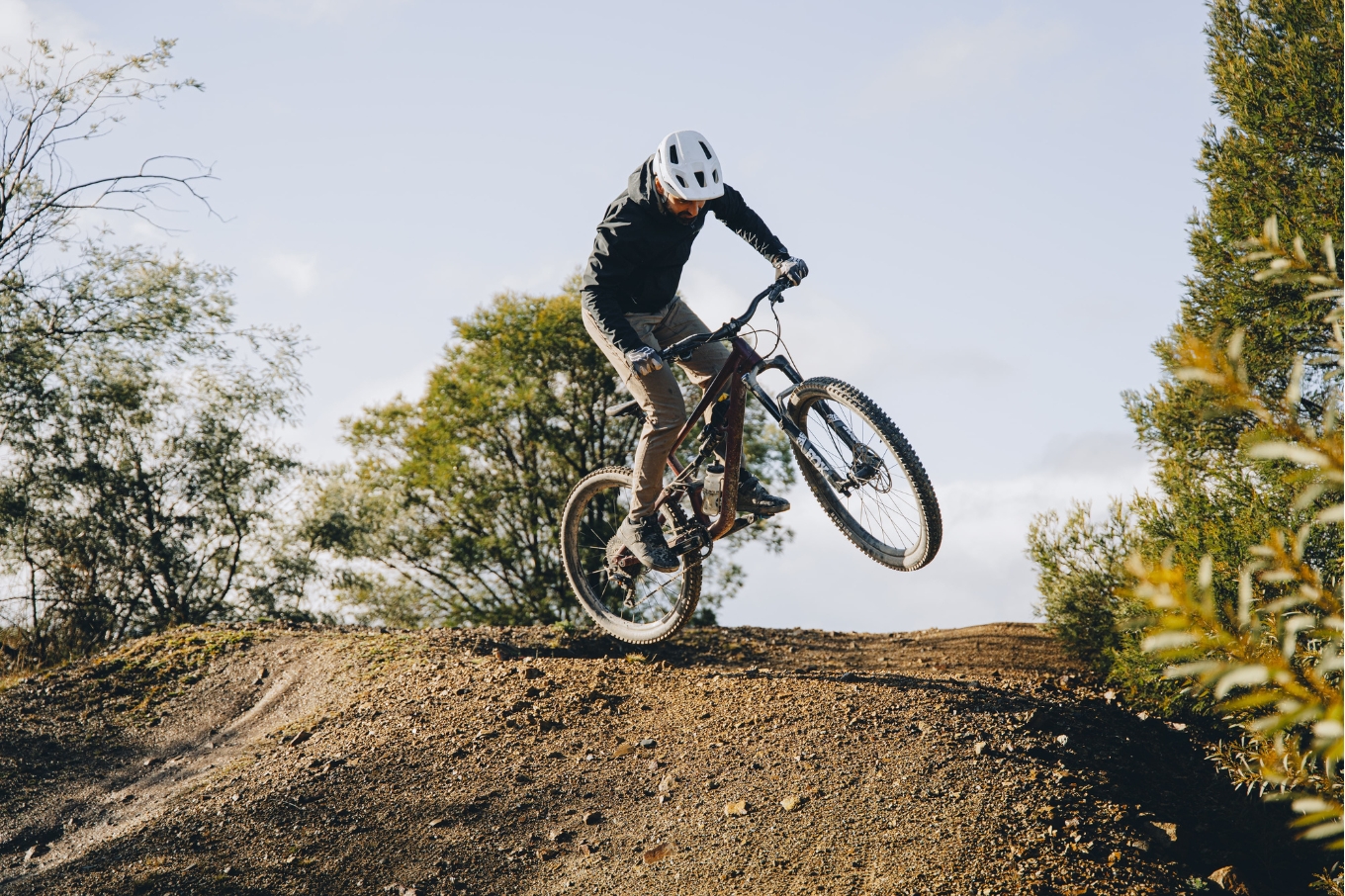Trails by rail in Switzerland
Singletrack meets railway tracks in Switzerland’s mountain paradise. With a country set to run like clockwork, and looking like a train set - why not get to the best spots by train?
Always on time, always clean, always simple, if not necessarily cheap for those paying in Aussie dollars, Swiss trains come with another special bonus – they’re incredibly bike friendly and connect all the best cycling spots with scenic trips, so you can sit back and take in the views between sessions.
Bikes are a part of Swiss leisure culture, so you won’t even score a glance when you climb aboard with your rig in tow. In fact, Swiss trains positively encourage the union of rubber and rail…
Easy to book, with a few handy ticket pass options to choose from, the best way to bike Switzerland’s 4,500km of marked tracks is most certainly by train. Here are AMB’s top train trips and tips on riding the trails they connect.

Glacier Express rides
Switzerland’s signature train trip, the Glacier Express, serendipitously joins two of the nation’s signature bike destinations as well: St Moritz in the Engadin Valley, and Zermatt, home of the Matterhorn. The Glacier Express is fondly touted as the world’s slowest express train. It’s a 291-kilometre journey through the mountainous southern parts of Switzerland, squeezing between mountains and dipping in and out of valleys, easing through 91 tunnels (including the 15-kilometre Furka tunnel) and crossing 291 bridges. The pace (about 36 kilometres an hour!) is deliberately slow, and huge panorama windows connect travellers with the scenery beyond the carriages. While the same journey can be done on ordinary trains, the antique dining carriage and special trimmings make this eight-hour journey the perfect rest day between epic bike rides.

At the Zermatt end of the Glacier Express it’s all about the towering Matterhorn. The inspiration behind the Toblerone deserves every bit of attention it gets, but Zermatt is fast acquiring a reputation for amazing mountain bike trails, too. The town hosts the start or finish of the Swiss Epic stage race every year, and with good reason.

The raw, technical, steep, and rocky terrain that surrounds Zermatt’s car-free cobbled town makes for ideal trail riding, while gourmet alpine restaurants line the terraced hillsides offering wondrous views to the mountains and excellent, healthy fare. With plenty of lifts and mountain trains running year-round, don’t miss the chance to head all the way up to the Rothorn at 3,100m for an ear-popping descent back down to Zermatt. Want to go furher? There's now a route down to Visp in the valley – adding another 1300m descent. Better yet, you take the trian back up.

At the other end, the riding around the luxury resort town of St Moritz can keep the keenest bikers busy for at least a week. The Corviglia Flow Trails, accessed by ski train from St Moritz, are the jewel in an otherwise richly-decorated crown. The Valley boasts loads of undulating forest trails around Silvaplana, and trails heading towards Samedan and beyond wind their way through pine-scented forests. Following these easy forest trails to Samedan will lead you to the beginning of one of Switzerland’s most rewarding and awe-inspiring rides – the Bernina Express.

The Bernina Express (signposted Swiss mountain bike route 673), runs between Samedan and Poschiavo, and is best ridden in that direction to take advantage of the drop in altitude.

The 45-kilometre route might look simple on paper, but its high altitude beginning and million photo opportunities can make for a long day out. The ride takes in a few good segments of narrow, winding singletrack, and tops out at about 2,250m at the halfway mark. From here it’s pretty much all flowy downhill riding to Poschiavo, right near the Italian border. Moving between forest, alpine scree, and grassy meadows, craggy alpine peaks tower above, and the Bernina Massif glacier dominates the skyline. The best way to enjoy the route is to take advantage of the rail system, taking the trail’s namesake, the scenic Bernina Express, back to Samedan or St Moritz from your touchdown at Poschiavo. Right after a pizza and Peroni.

From the Capital – Engelberg
It’s all about business in Zurich, the Swiss centre of commerce and punctuality, but hop on a clean, double-decker train and cruise to Engelberg. The trip takes about 2 hours, watch the neat concrete quickly give way to rolling green pastures and distant hills before being ejected into the alps. Engelberg is an immensely popular ski resort in the winter owing to its easy access from the big cities, and in summer its trails come alive with hikers and mountain bikers seeking fresh air and maximum elevation.

Unless signposted otherwise, hiking routes in Switzerland are open to mountain bikers, opening up nearly limitless possibilities for exploring the mountains. Our favourites include the Brunnihutte route for incredible views to the towering Mt Titlis and the town of Engelberg, or the Surenenpass for an immense day of riding. Then there’s the iconic Four Lakes trail, that takes in pristine Alpine waters and tops out at about 2,300m. Both these last rides are best done one-way, with an easy train trip back to Engelberg from the destination towns – or first via a ferry for the Four Lakes trail.

As an aside, The Golden Pass line is another grand rail network that allows you to link Central Switzerland’s Engelberg with the western part of Switzerland in Montreaux. From here you’d be mad not to visit Verbier’s custom-built bike park of steep, rocky runs, and the surrounding trails of the Valais.

Exploring under the Eiger
From the adventure town of Interlaken (an easy train ride from Zurich), you can hop on a train that winds up and up to either Grindelwald or Lauterbrunnen. Lauterbrunnen is well known for its stunning waterfall-sided town and for hosting extreme sports, including B.A.S.E. jumping and wingsuit flying on its cliffy slopes. Grindelwald is better known for the trio of mountains that dominate its flanks, the Jungfrau, the Monch, and the fearsome Eiger.

From Grindelwald it’s possible to travel all the way up to the Jungfraujoch, Europe’s highest railway station at 3,454 metres, then walk across towards the Monch, if conditions allow. The mountain biking in this part of Switzerland’s Bernese Oberland is raw and new. Hiking trails are being recruited to serve mountain bikers’ purposes and so the area invites exploration with a bit of flexibility and a sense of adventure.

Both Grindelwald and Lauterbrunnen boast immense trail networks, and the most incredible alpine backdrop for a day railing corners and hopping rocks. While there might be the occasional hike-a-bike, it’s worth it to see where you end up, and you can always incorporate trips on the bus and train to get more elevation to play with.

Riding the little red train
The Engadin Valley’s Rhatische Bahn, or little red train as we like to call it, is perhaps Switzerland’s most iconic rail line (both the Glacier Express and Bernina Express scenic lines are actually a part of its network). Running throughout the Graubunden Alps, the Rhaetian Railway is the largest alpine network in Switzerland, and the most spectacular. Immensely bike-friendly (there’s often a whole carriage for luggage that’s usually taken up only by bikes and their riders), this railway is a must-use for mountain bikers visiting the one of the most incredible mountain regions of the world.

AMB’s favourite section of the railway runs between Pontresina and Scuol in the south-eastern end of Switzerland, where the train connects dramatic alpine landscapes, each of which conceals a mountain bike adventure just waiting to be had. We’ve already talked about the virtues of St Moritz, but at the other end of the valley, towns like Scuol and S-Chanf hide their own treasures. The Rhaetian Railway is the perfect way to explore the trail-rich region of Graubunden.

Useful info
There are a lot of different options for rail travel and public transport tickets in Switzerland and throughout Europe, so it’s worth doing a bit of homework before you leave, depending which trains you plan to take. It’s worth considering a Swiss Rail Pass, which gives you unlimited use of the public transport network. Sold for 3, 4, 8 or 15 days, it also provides free entry hundreds of museums and exhibitions around the country. Otherwise, we recommend you consider a Half-Fare Pass, which for a one-off fee of 120CHF gives you half-price travel throughout the train network for a month.
Helpful info on trains and transport is available via My Switzerland, on whose main site you can also find endless, helpful tourism information.
For trail info, check the links above, and visit the relevant resorts and regions for details about lifts and maps. More generally the My Switzerland site has excellent maps and trail information.








